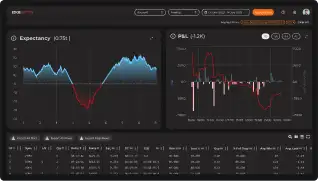
October 07,2025 @09:58 AM
Futures markets allow traders and institutions to speculate or hedge on the future price of an asset. In the U.S., long standing futures contracts like Crude Oil (CL) and Equity Index Futures (ES) are deeply established, regulated, and widely traded by a variety of market participants. More recently Cryptocurrency Futures (Crypto Futures), particularly those based on Bitcoin and Ethereum, have entered the mainstream through regulated exchanges like the CME.
While both categories share the same basic mechanics, what moves these markets, how they behave, and the risks involved differ. This article explores these differences, highlighting what traders should consider when navigating Crypto Futures compared to established contracts like CL or ES.
What Are Crypto Futures vs. “Traditional” Futures?
Traditional Futures (CL, ES): Crude Oil Futures (CL) are physically deliverable contracts, tied to the supply and demand dynamics of the global energy market. Equity Index Futures like the E-mini S&P 500 (ES) are cash-settled and offer exposure to a derivative of the S&P 500 Index.
Crypto Futures: The CME launched Bitcoin futures in 2017 and Ether futures in 2021. These contracts are cash-settled, notionally sized at 5 BTC and 50 ETH respectively, with smaller “micro” versions (0.1 BTC and 0.1 ETH) available to lower entry costs (CME Group, 2024). Unlike CL, there is no physical delivery in crypto; all settlement is financial.
Key Drivers for Price Movement in Different Markets
Crude Oil Futures (CL):
- Supply and Demand Fundamentals (OPEC decisions, U.S. shale production, global consumption)
- Geopolitical Risk (Middle East conflicts, sanctions)
- Macroeconomic Indicators (GDP growth, inflation)
- Inventory Data from the U.S. Energy Information Administration (EIA)
Equity Index Futures (ES):
- Corporate Darnings
- Federal Reserve Monetary Policy
- Economic Releases (jobs data, inflation, consumer confidence)
- Market Sentiment and Global Risk Appetite
Crypto Futures (BTC, ETH):
- Regulatory Developments (SEC rulings, global policy shifts)
- Network Events (Bitcoin halving, Ethereum upgrades)
- Market Sentiment Driven by Adoption Trends or Institutional Participation
- Liquidity Shifts, Especially During Risk-Off Environments
Volatility Comparison and Historical Trends
Crypto futures are notably more volatile than some “traditional” futures. Studies show that Bitcoin and Ethereum futures exhibit stronger and more persistent volatility shocks compared to commodities or equities (Scientific Reports, 2021). A study published in Energy Economics found that volatility spillovers between Bitcoin and oil markets exist, but crypto’s volatility tends to be more extreme and less tied to macroeconomic fundamentals (ScienceDirect, 2020).
Additionally, research from the Bank for International Settlements (BIS) highlights that the launch of Bitcoin Futures on CME increased trading volume and nearly doubled volatility due to speculative flows (BIS, 2022). By contrast, while CL and ES can experience large moves during news shocks, their volatility generally reverts more quickly to historical averages.
Understanding the Unique Risks in Crypto Futures
Funding Rates: While CME products are regulated and do not have perpetual contracts, offshore platforms often use funding rates to align futures prices with spot prices. These rates can create additional costs or gains for traders, but can also increase risk when swings are sharp (CoinSwitch, 2024).
Liquidation Cascades: Because of higher leverage and lower liquidity, crypto futures may see mass liquidations during rapid price declines. For example, in August 2025, over $750 million in crypto futures positions were liquidated in 24 hours (AInvest, 2025).
Exchange Vulnerability: Traditional futures products, like those traded through the CME are backed by clearinghouses. Crypto exchanges, however, have historically been vulnerable to hacks. The Bitfinex hack in 2016 led to $72 million in client losses (Fortune, 2016).
Margin & Carry Risks: According to the BIS, leveraged basis trades in crypto futures can unravel quickly, creating systemic liquidation risks not typically seen in regulated futures markets (BIS, 2022).
Key Considerations Before Trading Crypto Futures
- Margin and Leverage: CME requires significantly higher initial margin for Bitcoin and Ether Futures relative to CL or ES, reflecting higher volatility (Britannica, 2024).
- Liquidity: CL and ES have deep order books and consistent volume. By contrast, CME crypto futures trade less volume, and liquidity gaps can occur around major news events.
- Settlement: CL involves physical delivery unless offset, ES and crypto futures are cash-settled.
- Market Hours: While CL and ES trade nearly 24 hours a day, CME crypto futures are available nearly continuously, but the underlying spot markets trade 24/7 globally, creating additional weekend gap risk.
Practical Tips for Navigating Crypto Futures Safely
- Consider using conservative leverage and size down when trading crypto futures.
- Monitor network and regulatory developments in crypto, just as energy traders monitor OPEC or EIA reports.
- Consider volatility-adjusted stop placements, as crypto price swings can be several multiples of CL or ES. Keep in mind, stops are not guaranteed to fill and you should always closely monitor your positions.
- Stick to regulated exchanges, like CME, for risk management, clearing protections, and transparency.
Conclusion: Similar Mechanics, Very Different Markets
Both crypto futures and “traditional” futures, like CL or ES, present opportunities for traders, but the forces that move these markets are very different. Crude Oil Futures reflect supply and demand fundamentals, while crypto futures are more sentiment-driven and subject to technological and regulatory shocks. The volatility profile of crypto is significantly higher, and unique risks, like liquidation cascades and funding rates, make risk management critical.
Traders entering crypto futures from traditional markets should approach with caution, scale appropriately, and recognize the structural differences in liquidity, volatility, and market drivers.
Sources
- Britannica. “Crypto Futures Trading.” (2024).
- CME Group. “Frequently Asked Questions: Cryptocurrency Futures.” (2024).
- ScienceDirect. “Volatility spillovers between Bitcoin and oil.” Energy Economics (2020).
- Scientific Reports. “Volatility persistence in cryptocurrency markets.” (2021).
- BIS. “Crypto futures basis trades and systemic risk.” (2022).
- CoinSwitch. “Funding Rates in Crypto Futures.” (2024).
- AInvest. “$751M 24-Hour Crypto Futures Liquidations.” (2025).
- Fortune. “Bitfinex Hack.” (2016).
~ Giancarlo Saraceno, Senior Commodity Broker

